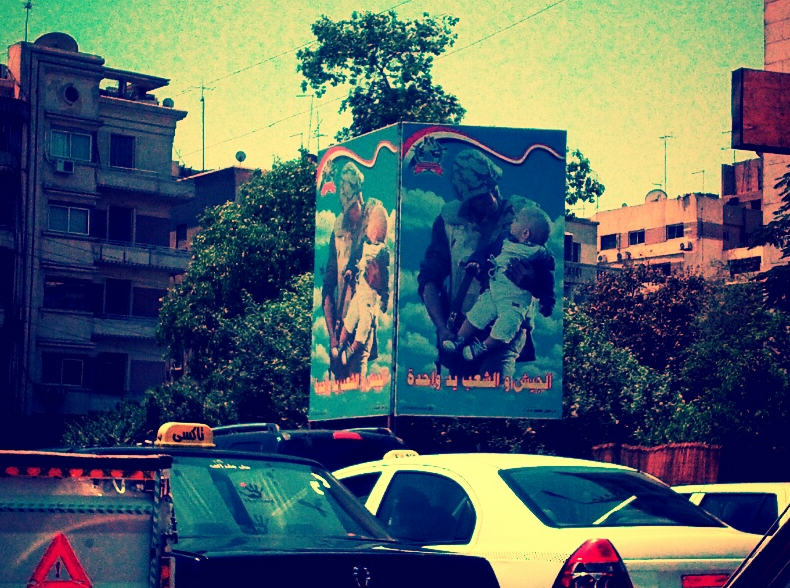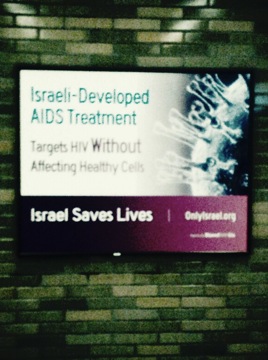Two Billboards by Nadia Gaber
|
This is a simple reflection on two billboards: one, the last I saw upon leaving the cacophonous streets of Cairo; the other, the first I saw upon arriving back in placid, progressive San Francisco.
In an early-morning taxi to the airport, I passed no fewer than four of these towering billboards: a small, white-skinned baby in the arms of a smiling armyman, the pair suspended in the clouds of a smogless blue sky. Al gaysh wa al-shaab eid wahda, it reads; the military and the people are one hand.
And then:
In a badly-lit BART station a seemingly benign ad for medical research hangs with the euphoric glint of a cure for AIDS. But its underlying agenda is betrayed in text: “Only in Israel” and “StandwithUs” signal the involvement of the PR mob that is the pro-Israel lobby. *** Truth be told, despite my engagement with the Egyptian revolution, this billboard surprised and angered me more, the first getting by on the comical charm of its Photoshopped odd couple. But this second one made my blood boil, using such a hopeful pronouncement to boast, with a complete lack of irony, “Israel Saves Lives,” while of course the state unleashes the epidemic of occupation on the Palestinian people. And so, I had traversed the globe in the modern time-fuck that is transcontinental air travel, leaving one banner representation of neoimperial authority to find that upon stepping off the train at home, There she was. The same Power, backed by the same superpower, dressed in thin veils: one relying on the sentimental affect of a cradled child, the other on the fantasy of scientific progress—a cure for our this intergenerational plague—both attempting to shroud an ethic of care in the arms of armed nationalisms. Both speaking to histories in conflict, pasts pitted against presents in the name of a future promise. *** Al gaysh wa al-shaab eid wahda slogan has been the military’s tagline since the early days of the revolution, when it did, in fact, appear that the army would defend the people’s right to protest against the commanding orders of the Supreme Council of the Armed Forces (SCAF). Soldiers’ refusal to fire on demonstrators helped usher Mubarak’s resignation, and until his Day of Departure, people were loudly chanting Al gaysh wa al-shaab eid wahda in the center of Tahrir Square. But then of course, things changed. In the power vacuum left behind, the military became increasingly militarized, as trained agents of war tend to do. By March, they were forcibly clearing the square with tactics meant to degrade, torture, and terrify dissidents. US-made tear gas was shot from close-range, so that the metal canisters added blunt trauma to the damage from exposure to the expired chemical neurotoxins. Women were subjected to ‘virginity testing,’ a shameless strategy of sexual terrorism against which violated women showed tremendous resilience. And protesters – most often the poorest and most defenseless– were rounded up in droves to be lashed with electric wires behind closed doors. In a violent appropriation of history, the Egyptian Museum itself became their chosen torture chamber, turning a space of civilization aspiration and collective memory against those pioneering to achieve no less than the radical advancement of their own society. For a country so deeply rooted in its ancient history, and so economically dependent on the world’s enduring fascination with that legacy, the Egyptian Museum is a secularly sacred space. Running far deeper than postcolonial nationalism(s), Egyptians’ identification with their Pharanoic predecessors – however scientifically or anthropologically tenuous – is amongst the more powerful sources of pride for a people whose exploitation in the current economic order erodes not only the quality of life, but its dignity. To be tortured in the museum, then, is to feel the pain of one’s own history subjugated and weaponized by a military junta. It is to be made a subject of history in a hall of its commemoration, knowing that the history you are writing at present may never make it outside this museum and onto its walls. Against the military’s claims, it was the protesters who worked as ‘one hand’ throughout this struggle, including encircling the Egyptian Museum (which sits just next to Tahrir Square) during the chaotic early days of the revolution to protect it from looters. Egyptians of all faiths held hands around a group of Christian protesters at the Maspero demonstrations, just before the army viscously attacked the crowd. And they stood hand-in-hand-in-hand in lines kilometers long to form passageways for motorcycles and scooters to evacuate wounded protesters to the makeshift field hospitals, created to treat those injured at the hands of the military. From this, the army has the audacity to print two large hands gripping the body of an infantilized Egyptian populous, representing partnership via paternalism, and set it in the wholly ahistorical and apolitical space of a bright blue sky. Meanwhile the peoples’ hands must work harder to loosen the suffocating grip of the state in order to fashion their own dignity, security, and history– whether as a basket of bread, a ride across town, or pyramid souvenirs. *** Perhaps it was because I had all this in mind that the sight of the Israeli campaign in the San Francisco subway was so devastating. Here again was a morally bankrupt state, an unabashedly colonial power, positioning itself as a savior—and so casually, right there in the subway. And because no one could believe that Israel and the Palestinians are one hand, these pro-Israel propagandists have co-opted the struggle of HIV/AIDS patients—a community whose struggles transcend political borders– in order to further the case for their existential imperialism. This is not to say that the researchers at Hebrew University who developed this treatment – an incredibly promising, but still preliminary advance – are not laudable for their efforts in the fight against AIDS, nor that the university itself is an agent of political repression (though a case could be made, given its ideologically Zionist founding and its 2004 settlement of Palestinian lands for dormitory expansion). But rather than focus upon the people whom it may help, or the scientific doors it may open, this ad is about nothing more than the state of Israel itself, using its medical machinery as metonym for its exceptional existence: “Only in Israel.” To use the promise of HIV-treatment to advance political Zionism—the driving ideology of the poster’s sponsors—is to forget that the history of the disease is that of a struggle against the eradication of vulnerable, marginalized populations. HIV/AIDS activism, in its US and global forms, have focused on campaigns against discrimination, poverty, and the structural inequalities that entrench the virus in susceptible communities. Zionism, if anything, is akin to the virus – threatening the lives of those whose race and class status (that is, Palestinians and particularly Gazans) leave them systematically at risk of suffering from the high morbidity and mortality characteristic of life under continued occupation. At least the virus is spread through sexual connection between people – often a loving one — and itself is blind to the identities of the victims it infiltrates; the Israeli state, however, has no such recourse to impartiality—its devasatation is deliberate, calculated, and targeted. The billboard is no less than an attempt to mask genocidal activity towards some with the good PR of scientific progress and humanitarian assistance towards others, and worse, to do so in the name of those who have collectively struggled — existentially struggled — against the threat of their own elimination. As if within a museum torture chamber, the history of one people, is here, too, being weaponized against another, against those simply fighting for bread, freedom, and social justice. *** The casual placement of these billboards along our global transit lines are harrowing reminders of the economic order in which we live; the unity of capitalism and militarism has never been stronger—nor have the media campaigns to mask them in the rhetoric of care, salvation, and security. That these two ads—one, an absurdist rendering of cooperation with a military junta; the other, a deviant appropriation of affect in the service of colonialist power – so tightly bookend my trip to opposite poles of the world speaks to the infectious reaches of the largest military industrial complexes of the Middle East. To those actively working to resist the reaches of capitalism, the scope of its penetration will come as no great revelation; but even if expected, the insidious timing, wording, and (lack of) context of these campaigns remains deeply saddening—all the more so for the positive rhetoric in which it is couched. If we can do nothing but laugh at, or tweet pictures of, these absurd images when we see them individually, we must together reclaim our histories—claim them tighter and louder than ever – if we are to resist the theft and subjugation of our collective past.
|


